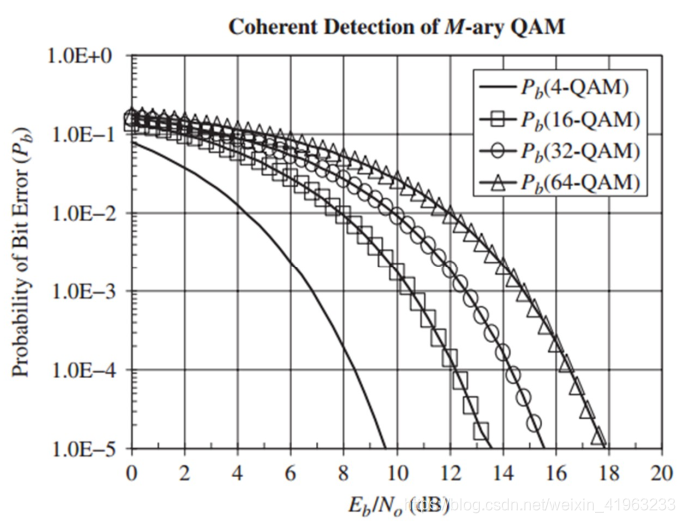BPSK、QPSK、MPSK、QAM、16QAM的调制解调Matlab实现 |
您所在的位置:网站首页 › qpsk调制与解调实验MATLAB › BPSK、QPSK、MPSK、QAM、16QAM的调制解调Matlab实现 |
BPSK、QPSK、MPSK、QAM、16QAM的调制解调Matlab实现
|
1、BPSK
目录 1、BPSK 2、QPSK 3、MPSK 4、QAM 相位状态表 表 1.1 BPSK相位状态表 Data bitPhase change001BPSK在AWGN信道中能够获得最好的误码率性能,频谱效率:1bps/Hz. 调制代码实现: function [mod_symbol] = bpskmod(bit_in) % bit_in = [0,1,0,0,1,1,1]; % only for test len = length(bit_in); table = exp(j*[0, pi]); mod_symbol = table(bit_in+1); %complex number %% method 2 % mod_symbol = 2*bit_in -1;解调时直接判断实部数据正负即可。 2、QPSK 表 2.1 QPSK相位状态表 Data bits (a(t)-b(t))QPSK频带效率:2bps/Hz。横穿或接近原点的相位轨迹,会增加峰平比(PAR),引起频谱增生,即带外辐射。 调制代码: function qpskSym = qpskmod(bit_in) % bit_in = randi([0,1], 1 ,10); % test data len = length(bit_in); % mapping (11,01 ,00, 10) % 1/4*pi , 3/4*pi ,-3/4*pi, -1/4*pi table= exp(j*[-3/4*pi,3/4*pi , -1/4*pi, 1/4*pi ]); % 0,1,2,3 inMatrix = reshape(bit_in, len/2,2); %Rs = 1/2Rb % inMatrix = [bit_in(1:2:end)', bit_in(2:2:end)']';% another way inInt = inMatrix(:,1)*2 + inMatrix(:,2); qpskSym = table(inInt+1);解调实现: % Function to perform QPSK demodulation function [demodata]=qpskdemod(idata,qdata,para,nd,ml) %****************** variables ************************* % idata :input Ich data % qdata :input Qch data % demodata: demodulated data (para-by-nd matrix) % para : Number of paralell channels % nd : Number of data % ml : Number of modulation levels % (QPSK ->2 16QAM -> 4) % ***************************************************** demodata=zeros(para,ml*nd); demodata((1:para),(1:ml:ml*nd-1))=idata((1:para),(1:nd))>=0; demodata((1:para),(2:ml:ml*nd))=qdata((1:para),(1:nd))>=0; %EOF3、MPSK MPSK调制阶数越高,ber性能越差,但频带利用率提高 实现方式采用: pskmod函数 4、QAMQAM调制方式的发送信号相位、幅度都会变化。在AWGN信道中,16QAM的ber性能优于16PSK,大约好4个dB。
调制实现: function qammod=qammod(qam_work,bits_in ) if qam_work == 1 full_len = length(bits_in); m=1; for k=-3:2:3 for l=-3:2:3 table(m) = (k+j*l)/sqrt(10); % power normalization m=m+1; end end table=table([0 1 3 2 4 5 7 6 12 13 15 14 8 9 11 10]+1); % Gray code mapping pattern for 8-PSK symbols inp=reshape(bits_in,4,full_len/4); qammod=table([8 4 2 1]*inp+1); % maps transmitted bits into 16QAM symbols end解调实现: % qamdemod.m % Function to decode 16QAM modulation function [demodata]=qamdemod(idata,qdata,para,nd,ml) %****************** variables ************************* % idata :input Ich data % qdata :input Qch data % demodata: demodulated data (para-by-nd matrix) % para : Number of paralell channels % nd : Number of data % ml : Number of modulation levels % (QPSK ->2 16QAM -> 4) % ***************************************************** k=sqrt(10); idata=idata.*k; qdata=qdata.*k; demodata=zeros(para,ml*nd); m2=ml/2; count2=0; for ii = 1:nd a=1; b=1; i_lngth=0; q_lngth=0; for jj= 1:m2 if jj ~= 1 if demodata((1:para),jj-1+count2)==1 a=-a; end if demodata((1:para),m2+jj-1+count2)==1 b=-b; end i_lngth=i_lngth+i_plrty.*2.^(m2-jj+1); q_lngth=q_lngth+q_plrty.*2.^(m2-jj+1); end if idata((1:para),ii) >= i_lngth demodata((1:para),jj+count2)=a>=0; i_plrty=1; else demodata((1:para),jj+count2)=a= q_lngth demodata((1:para),m2+jj+count2)=b>=0; q_plrty=1; else demodata((1:para),m2+jj+count2)=b |
【本文地址】
